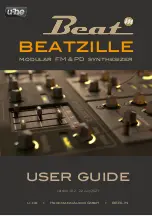
15
Arpeggiator
transpose is stepped downward by one
octave each time a reverse scan is
complete (likewise, with no scan direction
reverse) until a scan with a transpose of
0 is is complete. The scan direction then
switches again to forward and the entire
cycle repeats.
- With Random scan patterns, the Octave
Extend setting correspondingly extends
(by the specified number of octaves) the
set of possible output notes which the
random scan can produce – again, as if
the actual notes in the captured chord
have been replicated in higher octaves.
Repeat
When set to values other than zero, this
setting causes the arpeggiator to repeat
each output note for the specified number
of additional beats before proceeding to
scan the captured chord for a new note.
Repeat works with all scan modes and
scan patterns.
Sweep Transpose
This function can be used to produce a
dynamically variable "chord inversion"
style of upward transpose. Progressively
higher settings cause the currently
lowest
output note to be transposed
upward by one or more full octaves so
that it becomes the highest output note,
in effect rolling or "sweeping" the output
pattern up the keyboard one note at a
time – but without altering its "chord
value".
Sweep Transpose works with all scan
modes and scan patterns. The control
is ranged for a maximum transpose of
four octaves and automatically bases
itself with respect to the lowest note
actually being played on the keyboard
at any time. (Hint: the Sweep Transpose
control is a
natural for assignment to a
performance controller or another MIDI
Controller for "live" adjustment from the
keyboard.)

































